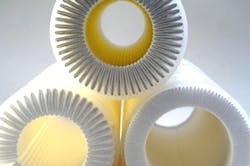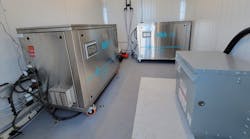1 . Match these three fluid characteristics in ultrafiltration with their commonly referenced terms.
1a. Feed supply to the membrane a. Retention
1b. Concentrate flow across the membrane b. Flux
1c. Permeate flow through the membrane c. Solute
2. True or False: Spacing of the molecule separation in the structure of reverse osmosis (RO) and ultrafilter membranes is specifically designed to control the separation performance of that particular membrane.
3. A boundary of increased solute concentration at the incoming face of the RO or ultrafilter membrane _________ the rejection of contaminants.
a. Increases
b. Decreases
4. Velocity in feed flow can ____________ membrane performance.
a. Enhance
b. Decrease
c. Enhance and decrease
5. The test that compares the initial time in seconds to filter 500 milliliters to the time to filter 500 milliliters after 15 minutes of water flowing through a 0.45 micron cellulose triacetate filter is known as the _______.
a. Membrane filter test
b. Silt density index test
c. Turbidity unit test
d. Filtrate test
6. The SDI measures _______.
a. Microbiological water quality
b. Scale-forming tendencies of the water
c. Colloidal matter in the water
d. Precipitate foulants
7. Pressure and flow readings to depict or diagnose membrane system operation are generally taken to monitor _______.
a. Feedwater
b. Permeate
c. Concentrate
d. All of the above
8. True or False: Permeate water quality from ultrafiltration is more easily monitored than that from RO.
Answers
1. 1a. c
1b. a
1c. b
2. True. The fundamental design concept for RO and ultrafilter membranes is that the membrane is a separation device that uses the spacing between the molecules as the filtrate flow path. The spacing between the molecules in a membrane is many times smaller than the spacing of the fibers or particles comprising different types of separation devices such as media or standard cartridge filters. This between-molecule flow path emphasizes that RO and ultrafiltration are, in essence, molecular filtration. It discriminates between molecules of different shapes and sizes and also between those of different molecular weights.
3. a. The gel layer-type of contaminant concentration buildup on the membrane’s incoming surface is called the dynamic membrane. Each fluid will possess an inherent driving force to have the concentration of each solution uniform throughout each fluid volume. When dynamics of pressure are applied, a flow across the membrane occurs. This flow causes a boundary layer on the feed side of the membrane where water is constantly being extracted. During tise phase, the rejected solute on the high pressure side accumulates in an unusually high concentration.
4. The need for velocity in feed flow is important to membrane design and operation. Relatively high flows are necessary to maintain a flushing (sweeping) action along the membrane surface and to prevent precipitant fouling of the membrane. However, a flow rate that is too high can waste water and diminish the formation of the dynamic membrane or gel layer, which can also affect separation as explained in No. 3.
5. b
6. c. The silt density index results give a general indication of the colloidal matter of a feedwater source and indicate the degrees of prefiltration required ahead of RO membrane systems or the loading demand of ultrafilter membrane systems.
7. d. The two most important pressure readings are the feedwater and the permeate water. A feed-to-concentrate pressure drop should be relatively constant in the operating mode. A long-term increase in this pressure differential (ΔP) is probably typical. A sudden drop to a zero pressure differential generally means a membrane or system rupture. Conversely, a sharply increased ΔP probably indicates a fouled membrane. Flow measurements show the relationship between permeate and concentrate or reject quantities. This should be maintained at a constant ratio.
8. False. Ultrafiltered water quality is not as easily measured as RO water quality. Electronic measurement of dissolved solids by comparable conductance or resistance is not available to detect the full molecular weight screen range of the ultrafilter. Large ultrafiltration systems sometimes use total organic analyzers and/or particle counters, but these analytical monitoring devices are too expensive for many smaller ultrafiltration system applications, including point of use.


